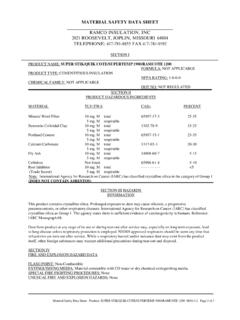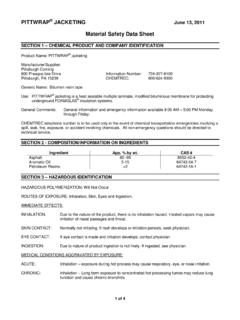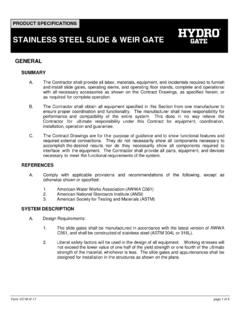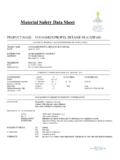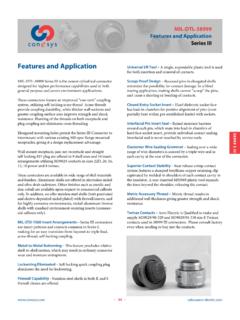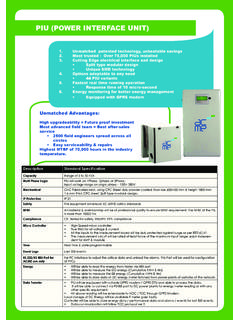Transcription of Material Safety Data Sheet - ACME INSULATIONS
1 IIG 20501 Page 1 of 4 Copyright 2012 Date: 27 Aug 2012 MSDS ID: 20501 Revision: Replaces: 9 Feb 2012 Material Safety data SheetMaterial Name: Calcium Silicate 1 - Chemical Product and Company IdentificationProduct Name: Thermo-12 GoldManufacturer InformationIndustrial Insulation Group, LLC 2100 Line StreetBrunswick, GA 31520 Chemical or Medical Emergency call INFOTRAC (24/7) 1-800-553-5053 Outside the US call collect +1-352-323-3500 Section 2 - Composition and Information on Ingredients OSHA ACGIH CAS# EINECS Component Percent PEL TLV UNITS1344-95-2 215-710-8 Synthetic Calcium Silicate >90 15 10 mg/M31344-09-8 1344-09-8 Sodium Silicate 0 - 6 15 10 mg/M39004-34-6 9004-34-6 Cellulose Fiber 0 - 4 15 10 mg/M361788-77-0 61788-77-0 Synthetic Cellulose Fiber 0 - 4 15 10 mg/M365997-17-3 266-17-3 Synthetic Vitreous Fiber 0 - 4 1 1 f/cc51274-00-1 215-176-6 Iron Based Color 0 - 1 15 10 mg/M3NE = Not EstablishedSection 3 - Hazards IdentificationEmergency Overview.
2 IrritantAppearance: Yellow semi-circle or block insulation with coloring throughout as a visual marker to indicate this is an asbestos-free : OdorlessWarning Statements: This product is an article and under normal conditions of use, this product is not expected to create any unusual emergency hazards. However, cutting, sawing, or abrading may increase the risk of personnel exposure. Pre-existing chronic respiratory, skin, or eye diseases or conditions may be aggravated by exposure to this Health EffectsInhalation of excessive amounts of dust created when fabricating, cutting, or other mechanical alterations of the product may cause temporary upper respiratory irritation and/or congestion, remove affected individual(s) to fresh air. Breathing large amounts of dust or fibers from this product may lead to chronic health effects as discussed in Section 11 of this Material Safety data irritation may be treated by gently washing affected area with soap and warm irritation may be treated by flushing eyes with large amounts of water.
3 If irritation persists, contact a 4 - First Aid MeasuresFirst Aid: InhalationRemove to fresh air. Drink water to clear throat, and blow nose to remove Aid: SkinWash gently with soap and warm water to remove dust. Wash hands before eating or using the rest room. Never use compressed air to remove dust or fibers from the Aid: IngestionProduct is not intended to be ingested or eaten. If this product is ingested, irritation of the gastrointestinal (GI) IIG 20501 Page 2 of 4 Copyright 2012tract may occur, and should be treated symptomatically. Rinse mouth with water then drink plenty of water to help reduce the irritation. No chronic effects are expected following Aid: EyesDo not rub or scratch your eyes. Dust particles may cause the eye to be scratched.
4 Flush eyes with large amounts of water for 5-15 minutes. If irritation persists, contact a medical Aid: Notes to PhysicianThis product is a mechanical irritant, and is not expected to produce any chronic health effects from acute exposures. Treatment should be directed toward removing the source of irritation with symptomatic treatment as 5 - Fire Fighting MeasuresFlash Point: Not applicable Method Used: Not applicableUpper Flammable Limit (UFL): Not applicable Lower Flammable Limit (LFL): Not applicableAuto Ignition: Not determined Flammability Classification: Non combustibleRate of Burning: Not applicableGeneral Fire Hazard:There is no potential for fire or Media:Use any extinguishing media appropriate for the surrounding Fighting Equipment/Instructions:No special procedures are expected to be necessary for this product.
5 Normal fire fighting procedures should be followed to avoid inhalation of smoke and gases produced by other 6 - Accidental Release MeasuresContainment Procedures:Pick up large pieces. Vacuum dust. If sweeping is necessary, use a dust suppressant such as water. Do not dry sweep dust accumulation or use compressed air for clean-up. These procedures will help to minimize potential Procedures:Wastes are not hazardous as defined by the RCRA (40 CFR 261). Comply with state and local regulations for disposal of these products. If you are unsure of the regulations, contact your local Public Health Department, or the local office of the Environmental Protection Agency (EPA).Section 7 - Handling and StorageHandling Procedures:Use protective equipment as described in Section 8 of this Material Safety data Sheet when handling uncontained Material .
6 Good housekeeping practices should be used to prevent generation and accumulation of dusts. After handling product, wash face and hands before eating, drinking, or Procedures:Warehouse storage should be in accordance with guide specifications and/or product data Sheet . Material should be kept dry, and protected from the 8 - Exposure Control and Personal ProtectionGeneral Product InformationThis product may contain trace amounts of crystalline silica as a natural contaminant in the raw , standard industrial hygiene air monitoring surveys conducted under normal and test (worst-case) situations have not detected any reportable crystalline silica in the respirable dust in the occupational Protective Equipment: Eyes/FaceSafety glasses with side shields are recommended to keep product out of the Protective Equipment: SkinLeather or cotton gloves should be worn to prevent skin contact and irritation.
7 Barrier creams may also be used to reduce skin contact and Protective Equipment: RespiratoryA respirator should be used if ventilation is unavailable, or is inadequate for keeping dust and fiber levels below the applicable exposure limits. Operations such as sawing, fabricating, or cutting may generate airborne particulate concentrations requiring a higher level of respiratory protection. In those cases, use a NIOSH-certified disposable or reusable particulate respirator with an efficiency rating of N95 or higher (under IIG 20501 Page 3 of 4 Copyright 201242 CFR 84) when working with this product. For exposures up to five times the established exposure limits use a quarter-mask respirator, rated N95 or higher. For exposures up to ten times the established exposure limits use a half-mask respirator ( , MSA s DM-11, Racal s Delta N95, 3M s 8210), rated N95 or higher.
8 For exposures up to 50 times the established exposure limits use a full-face respirator, rated N99 or fixed manufacturing settings, local exhaust ventilation should be provided at areas of cutting to remove airborne dust and fibers. General dilution ventilation should be provided as necessary to keep airborne dust and fibers below the applicable exposure limits and guidelines. The need for ventilation systems should be evaluated by a professional industrial hygienist, while the design of specific ventilation systems should be conducted by a professional Protective Equipment: GeneralLoose-fitting, long sleeved clothing should be worn to protect the skin from irritation. Exposed skin areas should be washed with soap and warm water after 9 - Physical & Chemical PropertiesAppearance: Semi-circle or block insulation with yellow coloring throughout as a visual marker to indicate this is an asbestos free : Odorless pH: Not applicablePhysical State: Solid Vapor Density: Not applicableVapor Pressure: Not applicable Melting Point: 1200 - 1500 CBoiling Point: Not applicable Specific Gravity: - (H2O): Nil Freezing Point: Not applicableViscosity: Not applicable Evaporation Rate: Not applicableVOC: 0, None Percent Volatile: 0 Section 10 - Chemical Stability & Reactivity InformationChemical StabilityThis is a stable Material .
9 This product is not PolymerizationWill not 11 - Toxicological InformationCarcinogenicityACGIH: A4 - Not Classifiable as a Human : Group 3, Not 12 - Ecological InformationThis product should not have any impact on the 13 Disposal ConsiderationsWear proper PPE as instructed in Section 8. This product is not regulated as a hazardous waste by the EPA under RCRA regulations. Comply with state and local regulations for 14 - Transport InformationFollow the instructions in Section DOT Classification for highway: Not Shipping Description: Not Shipping Description: Nor 15 - Regulatory InformationSARA Hazard Notification/ReportingImmediate = NO Fire = NO Sudden Release of pressure = NODelayed = NO Reactive = NOIIG 20501 Page 4 of 4 Copyright 2012 SARA Title 313, Toxic chemicals: NoneExtremely hazardous substances (EHS): NoneSARA/OSHA Hazardous chemical reporting quantity (RQ): NoneTSCA: NoneRCRA Hazardous waste: NoneWHMIS: D2B IrritantEINECS: IrritantHazard symbols: Irritant, XRisk phrases: R20, Harmful by inhalation; R22, Harmful if swallowed; R36, Irritating to eyes.
10 And R37, Irritating to the respiratory phrases S2, Keep out of reach of children; S36, Wear suitable protective clothing; S39, Wear eye/face protection; and S51, Use only in well-ventilated product has been classified according to the hazard criteria of the CPR and the MSDS contains all the information required by the 16 - Other InformationNFPA HMIS Rating Scale1 - Health 1 - Health 0 Least0 - Flammability 0 - Flammability 1 Slight0 - Instability 0 - Physical 2 ModerateNo Special E - PPE 3 High 4 SevereKey/Legend:EPA = Environmental Protection Agency; TSCA = Toxic Substance Control Act; ACGIH = American Conference of Governmental Industrial Hygienists; IARC = International Agency for Research on Cancer; NIOSH = National Institute for Occupational Safety and Health; NTP = National Toxicology Program; OSHA = Occupational Safety and Health Administration; NFPA = National Fire Protection Association; HMIS = Hazardous Material Identification System; RCRA = Resource Conservation and Recovery Act; CERCLA = Comprehensive Environmental Response, Compensation and Liability Act; SARA = Superfund Amendments and Reauthorization Act; DSL = Canadian Domestic Substance List; EINECS = European Inventory of New and Existing Chemical Substances; WHMIS = Workplace Hazardous Materials Information System; CAA = Clean Air Act; CHPA=Canadian Hazardous Product Act.

